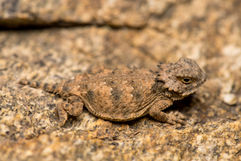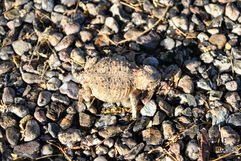Regal Horned Lizard
Phrynosoma solare

The Regal Horned Lizard is a medium-sized, wide-bodied lizard reaching up to 117 mm (about 4.6 inches) from snout to vent. It is notably flat, with a short tail and a crown of dagger-like horns projecting from the rear and sides of the head. The four central horns are the most prominent, their bases fused together, a distinctive feature among Arizona's horned lizards. Its back is covered with isolated pointed scales, and a row of sharp fringe scales runs along each lower side of the body. The anterior limbs are also adorned with enlarged, keeled, and pointed scales. Its coloration—ranging from reddish-brown to gray or tan—often blends seamlessly with its surroundings. Typically, a lighter patch dominates the center of the back, bordered by darker sides, and some individuals display a faint mid-dorsal stripe or dark, muted neck blotches. The underside is pale with occasional dark speckling.


References:
Stebbins, R. C., & McGinnis, S. M. (2018). Peterson Field Guide to Western Reptiles and Amphibians (4th ed.). Houghton Mifflin Harcourt.
Brennan, T. C. (n.d.-e). Regal Horned Lizard. The Reptiles and Amphibians of Arizona. https://reptilesofaz.org/lizards-subpages/h-p-solare/
Brennan, T. C., & Holycross, A. T. (2006). A field guide to Amphibians and reptiles in Arizona (2nd ed.). Arizona Game and Fish Dept.

















